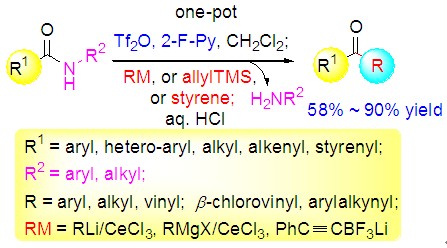[1] Li, C.-J.; Trost, B. M.
Proc.
Natl.
Acad.
Sci.
2008,
105, 13197.
[2] For a recent review, see: Albrecht, L.; Jiang, H.; Jørgensen, K. A.
Angew.
Chem.
Int.
Ed.
2011,
50, 8492.
[3] For leading reviews, see: (a) Pellissier,
H.
Tetrahedron 2006,
62, 1619 and 2143;

(b) Guo, H.-C.; Ma, J.-A.
Angew.
Chem.
Int.
Ed.
2006,
45, 354.
[4] For a leading book, see:
Multicomponent Reactions, Eds.; Zhu, J.-P.; Bienaymé, H., Wiley-VCH, Weinheim,
2005.

[5] Wender, P. A.; Croatt, M. P.; Witulski, B.
Tetrahedron 2006,
62, 7505.

[6] Xu, C.-P.; Xiao, Z.-H.; Zhuo, B.-Q.; Wang, Y.-H.; Huang, P.-Q.
Chem.
Commun.
2010,
46, 7834.
[7] Liu, X.-K.; Zheng, X.; Ruan, Y.-P.; Ma, J.; Huang, P.-Q.
Org.
Biomol.
Chem.
2012,
10, 1275.
[8] Wang, Y.-H.; Ye, J.-L.; Wang, A.-E; Huang, P.-Q.
Org.
Biomol.
Chem.
2012,
10, 6504.
[9] Zheng. J.-L.; Liu, H.; Zhang, Y.-F.; Zhao, W.; Tong, J.-S.; Ruan, Y.-P.; Huang, P.-Q.
Tetrahedron:
Asymmetry 2011,
22, 257.

[10] Xiao, K.-J.; Luo, J.-M.; Ye, K.-Y.; Wang, Y.; Huang, P.-Q.
Angew.
Chem.
Int.
Ed.
2010,
49, 3037.
[11] (a) Xiao, K.-J.; Wang, Y.; Ye, K.-Y.; Huang, P.-Q.
Chem.
Eur.
J.
2010,
16, 12792;

(b) Liao, J.-C.; Xiao, K.-J.; Zheng, X.; Huang, P.-Q.
Tetrahedron 2012,
68, 5297.

[12] Xiao, K.-J.; Wang, A.-E; Huang, P.-Q.
Angew.
Chem.
Int.
Ed.
2012,
51, 8314.
[13] (a) Shi, Z.; Li, B.; Wan, X.; Cheng, J.; Fang, Z.; Cao, B.; Qin, C.; Wang, Y.
Angew.
Chem.
Int.
Ed.
2007,
46, 5554;
(b) Wang, X.; Leow, D.; Yu, J.-Q.
J.
Am.
Chem.
Soc.
2011,
133, 13864;
(c) Zultanski, S. L.; Fu, G. C.
J.
Am.
Chem.
Soc.
2011,
133, 15362;
(d) Chen, Q.; Ilies, L.; Nakamura, E.
J.
Am.
Chem.
Soc.
2011,
133, 428.
[14] For a recent review, see: Trost, B. M.; Brindle, C. S.
Chem.
Soc.
Rev.
2010,
39, 1600.
[15] For selected reviews, see: (a) Abell, A. D.; Edmonds, M. K. In
Organophosphorus Reagents; Ed.: Murphy, P. J., Oxford University Press, Oxford,
2004, p. 99;

(b) Kolodiazhnyi, O. I.
Phosphorus Ylides:
Chemistry and Applications in Organic Chemistry, Wiley-VCH, New York,
1999;

(c) Maryanoff, B. E.; Reitz, A. B.
Chem. Rev.
1989,
89, 863.

[16] For a recent review, see: Krause, N.; Hoffmann-Röder, A.
Synthesis 2001,
2, 171.
[17] (a) Nahm, S.; Weinreb, S. M.
Tetrahedron Lett.
1981,
22, 3815. For a recent review, see:

(b) Balasubramaniam, S.; Aiden, I. S.
Synthesis 2008, 3707.
[18] Martín, R.; Romea, P.; Tey, C.; Urpí, F.; Vilarrasa, J.
Synlett 1997, 1414.
[19] Bechara, W. S.; Pelletier, G.; Charette, A. B.
Nat.
Chem.
2012,
4, 228. This work appeared while we were submitting our own manuscript. The two methods are complementary as a general methodology for the transformation of secondary amides to ketones in terms of the scope, reaction conditions and nucleophiles used.
[20] Xiao, K.-J.; Wang, A.-E; Huang, Y.-H.; Huang, P.-Q.
Asian J.
Org.
Chem.
2012, DOI: 10. 1002/ajoc. 201200066.
[21] For reviews on the chemistry of triflic acid and its derivatives, see: (a) Stang, P. J.; White, M. R.
Aldrichimica Acta 1983,
16, 15.
(b) Baraznenok, I. L.; Nenajdenko, V. G.; Balenkova, E. S.
Tetrahedron 2000,
56, 3077. For selected recent examples, see:

(c) Charette, A. B.; Grenon, M.; Lemire, A.; Pourashraf, M.; Martel, J.
J.
Am.
Chem.
Soc.
2001,
123, 11829;
(d) Movassaghi, M.; Hill, M. D.; Ahmad, O. K.
J.
Am.
Chem.
Soc.
2007,
129, 10096;
(e) Zhou, H.-B.; Liu, G.-S.; Yao, Z.-J.
J.
Org.
Chem.
2007,
72, 6270;
(f) Cui, S.-L.; Wang, J.; Wang, Y.-G.
J.
Am.
Chem.
Soc.
2008,
130, 13526;
(g) Barbe, G.; Charette, A. B.
J.
Am.
Chem.
Soc.
2008,
130, 18;
(h) Dong, Q.-L.; Liu, G.-S.; Zhou, H.-B.; Lin, C.; Yao, Z.-J.
Tetrahedron Lett.
2008,
10, 1636.
[22] Harder, I.; Hanack, M.
Chem.
Ber.
1984,
117, 3004.
[23] Medley, J. W.; Movassaghi, M.
J.
Org.
Chem.
2009,
74, 1341.
[24] For the preparation of organocerium reagents from RLi, see: (a) Imamoto, T.; Sugiura, Y.; Takiyama, N.
Tetrahedron Lett.
1984,
25, 4233. For the preparation of organocerium complexs from RMgX, see:

(b) Imamoto, T.; Takiyama, N.; Nakamura, K.; Hatajima, T.; Kamiya, Y.
J.
Am.
Chem.
Soc.
1989, 111, 4392. For a recent review, see:

(c) Bartoli, G.; Marcantoni, E.; Marcolini, M.; Sambri, L.
Chem.
Rev.
2010,
110, 6104.
[25]
Enones, Eds.: Patai, S.; Rappoport, Z., Wiley, Chichester,
1989, Vol. 1.

[26] (a) Pohland, A. E.; Benson, W. R.
Tetrahedron 1966,
66, 161;
(b) Iwai, T.; Fujihara, T.; Terao, J.; Tsuji, Y.
J.
Am.
Chem.
Soc.
2012,
134, 1268.
[27] Yamaguchi, M.; Waseda, T.; Hirao, I.
Chem.
Lett.
1983,
12, 35.

[28] For the synthesis of furans, see: (a) Jeevanandam, A.; Narkunan, K.; Ling, Y.-C.
J.
Org.
Chem.
2001,
66, 6014;
(b) Kel’in, A. V.; Gevorgyan, V.
J.
Org.
Chem.
2002,
67, 95. For the synthesis of pyrazoles, see:
(c) Wang, X.; Tan, J.; Zhang, L.
Org.
Lett.
2000,
2, 3107;
(d) Grotjahn, D. B.; Van, S.; Combs, D.; Lev, D. A.; Schneider, C.; Rideout, M.; Meyer, C.; Hernandez, G.; Mejorado, L.
J.
Org.
Chem.
2002,
67, 9200.
[29] For a related mechanism involving an intramolecular hydride transfer to give an immonium ion, see: Heathcock, C. H.; Kath, J. C.; Ruggeri, R. B.
J.
Org.
Chem.
1995,
60, 1120.
[30] Fukuda, Y.; Utimoto, K.
Bull.
Chem.
Soc.
Jpn.
1991,
64, 2013.
[31] Hosseini-Sarvari, M.; Mardaneh, Z.
Bull.
Chem.
Soc.
Jpn.
2011,
84, 778.
[32] Liu, J.; Peng, X.; Sun, W.; Zhao, Y.; Xia, C.
Org.
Lett.
2008,
18, 3933.
[33] Kawakami, T.; Miyatake, M.; Shibata, I.; Baba, A.; Matsuda, H.
J.
Org.
Chem.
1996,
61, 376.


















